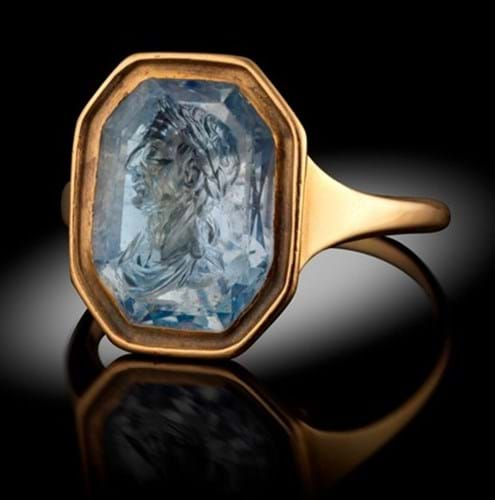
At the eleventh hour the ring, with its octagonal faceted stone carved with the bust of a Roman emperor (probably Julius Caesar), has been re-catalogued. The Renaissance gem is now expected to improve markedly on its £600-800 estimate when offered for sale at Woolley & Wallis on July 18.
The collection of about 800 engraved gems formed by the nobleman and politician George Spencer, 4th Duke of Marlborough (1739-1817) was the largest and most important of the age. It resided at Blenheim Palace until it was sold by the 6th Duke en bloc at Christie, Manson & Woods in 1875 to mining magnate David Bromilow (1809-98) of Bitteswell Hall, Leicestershire for £35,000. It was then dispersed piecemeal by Christie’s in 1899.
The present whereabouts of two thirds of the gems is now unknown although the Beazley archive in Oxford possesses impressions and electrotype copies of virtually every Marlborough gem as well as the cataloguer's notebooks. It was these that were published as The Marlborough Gems: Formerly at Blenheim Palace, Oxfordshire in 2009.
‘Lost’ jewels
The Salisbury jewel, that came by descent from Mary Anne, Viscountess Hereford (1843-1924), is listed among the ‘lost’ jewels. It is thought to be that numbered ‘208 Laureate bust of Julius Caesar’ in the recent catalogue and was lot 381 in Christie’s 1899 sale. Listed under the section titled Roman and Post Augustan Portraiture it is described as 'An Intaglio. The same subject (as previous lot) with still less of the character of Julius Caesar. A work, remarkable for the stone that it is upon - a sapphire; the head is to the left. An Arundel Gem.’
The latter is a reference to the collection assembled by the courtier and grand tourist Thomas Howard, 21st Earl of Arundel (1585-1646) - one of the first Englishmen to collect classical sculpture and gems. The Arundel gems, many acquired through his agent William Petty (c.1585-1639) in Italy, passed by descent to Charles Spencer, 3rd Duke of Marlborough (1706-58).
Elements of the Marlborough collection formed part of Christie’s New York sale titled Masterpieces in Miniature: Ancient Engraved Gems Formerly in the G. Sangiorgi Collection on April 29. Half of the sale was purchased by the Getty Museum.





